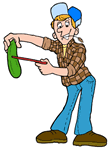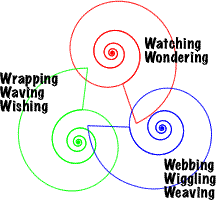 The Best of the Web
The Best of the Web
Are your students choosing the best the web has to offer or are they simply "googling, copying, and reporting"?
Educators talk a lot about using "websites," but what does this mean? The word simply describes a delivery system for information like a book or a television program. It's like talking about the farm truck when we are really interested in the quality of the fruits and vegetables at the market. Start by exploring the best the web has to offer. Then, seek out other materials to supplement what you find.
Locate Quality Starting Points
 Instead of searching for materials to match specific units, you’ll have more luck if you keep your mind open to the possibilities. Browse resources and collections. How could these lesson resources and primary source collections be used at your grade level and subject area? Seek out alternative ways to address standards.
Instead of searching for materials to match specific units, you’ll have more luck if you keep your mind open to the possibilities. Browse resources and collections. How could these lesson resources and primary source collections be used at your grade level and subject area? Seek out alternative ways to address standards.
Look for the classics. The kids would probably choose Captain Underpants over Shakespeare, but how about a compromise? Choose engaging resources from credible sources! For instance, students might choose to read Journey to the Center of the Earth by Jules Verne in graphic novel format from Stone Arch Books. Can you find good Internet resources that are visually attractive to motivate young people?
When you go to the library, it's easy to separate the fiction books from the nonfiction and reference books. When you're online, it's much more difficult to locate the particular type of information you need. Use the following resources to get you started locating quality web-based content.
- Government Resources: USA.gov, Kids.gov
- Government Agencies: NOAA, NASA, CDC, USGS, NIH, NPS, EPA
- Public Resources: PBS, PBSKids, BBC, CBC, NPR
- Organizations: NWF enature, All About Birds
- Libraries: Teacher Tap
- Museums: Teacher Tap
- Interactives - Flash Projects
- Pathfinders - 42explore, Emints - alphabetically, by grade level, Pathfinder Links
- Directories - ALA 800, Kathy Schrock's Guide, Homework Center from Multnomah County Library, Kid's Click, Internet Public Library, Content Coliseum
- By Teachers for Teachers - Web English Teacher
- By Kids for Kids - ThinkQuest
- Content Areas - Teacher Tap
Explore the dozen starting points above.
In what situations would these starting points be useful? Where do they lead? When are starters ineffective?
Select a Variety of Resources
As you explore online materials, choose a variety of resources. Select varied channels of communication such as text, graphics, audio, video, photographs, and animations. Seek out primary source materials including original documents, speeches, posters, interviews, and other authentic materials. Meet individual needs by looking a varied reading levels and presentation styles. Also locate materials that will support standards across the curriculum including science, social studies, communication skills, math, and others.





Print Resources
- How Groundhog's Garden Grew by Lynne Cherry
- Tops and Bottoms by Janet Stevens
- Uno's Garden by Graeme Base
- Up, Down, and Around by Katherine Ayres
- The Victory Garden by Lee Kochenderfer
Categories of Web Resources
English
- American Girl: Molly (World War II era)
- Discussion Ideas (PDF)
- Lee Kochenderfer Author Website
- Author Visit
- Victory Garden Poem
History of Victory Gardens
- Library of Congress - Primary source documents (i.e., photographs, documents, oral histories)
- National Archives - War posters
- Farming in the 1940s
- Life on the Homefront
- Smithsonian - Within These Walls - The Scotts virtual exhibit
- Student Works - Victory Garden
- Interview - email people with experience
- General Resources
History of Gardens
- History of Gardening from BBC
Health and Science of Gardening
- USDA - Hardiness zones
- Department of Agriculture - Photos for Victory Garden scrapbook
- Fenway Victory Gardens (non-profit organization)
- Expert Interviews - emai your county extension office
- Collaborative Projects - Journey North - trace tulip growth
- University Project - Kids Growing Food
Calculators
- Gardening Calculators from National Gardening Association
General Gardening
- 42explore - Gardening
- BBC - Gardening
- Plants - links to check
- Horticulture from Smithsonian
Websites for Kids
- Camp Silos - Based on Questions
- Interactive Garden
- Kid Gardening
- Kid's Valley Garden
- KinderGarden - teaching resources
- The Great Plant Escape - interactive
- My First Garden - information
Brainstorm all the types of information and categories of information that might be useful for teaching and learning. Create a chart of types of content (online books, lists and directories, virtual exhibit, dictionary, encyclopedia, primary sources, news, biographies, guides, databases, advice and opinions, data (statistics, tables, observations, experiments), chronologies, how-tos, periodicals, news, forms, contact information, reports, trivia), bibliography.
Use Primary Source Materials
- Children
- Dragonwings by Laurence Yep
- The Earth Dragon Awakes by Laurence Yep
- Young Adults
- A Crack in the Edge of the World: America and the Great California Earthquake of 1906 by Simon Winchester



Web Resources
- Museum of the City of San Francisco (Eyewitness Interviews)
- The Great 1906 San Francisco Earthquake from USGS (Science Data)
- San Francisco Earthquake of 1906 from LOC (Photographs)
- On This Day from The New York Times (Original Newspaper)
- San Francisco's 1906 Quake: What If It Struck Today? from National Geographic
- EarthQuake Science
Analyzing Primary Sources
- History in the Raw from National Archives - teaching with documents
- Using Primary Sources in the Classroom from Library of Congress
Other Primary Source Document Lesson Ideas
- Chronology of US Historical Documents
- Library of Congress: Collection Connections
- English and Language Arts
- Fine and Applied Arts
- Math, Science, & Technology
- Social Studies
- Advertising
- Community Center
- Eras: Early America,
- Events: Summertime, United States Holidays
- Exploration and Explorers, Lewis & Clark
- Geography: America,
- Government: Elections, Political Cartoons, We the People
- Movements: Civil Rights, Labor, Women's History,
- People: Asian Pacific Americans, Immigration, Native Americans
- Wars: Civil Wars, Great Depression, War and Peace
- Other Areas
-
Sports: Baseball
Explore primary source materials. Select a topic and consider the primary source materials that might be used as part of a springboard activity.
 Infuse Information Skills
Infuse Information Skills
For students to make effective use of online resources, they need information and communication skills. Explore some of the following skill areas:
- Inquiry Models
- The Ws
- Questioning
- Search Strategies
- Search Tools
- Evaluating Internet Resources
- Skimming, Scanning, Scrolling, and Sensemaking
- Copyright
- Citing Sources
- Plagiarism
- Summarizing and Note-taking
What skills do students need to successfully use Internet resources? Select one of the areas above to explore in-depth. Design an activity that requires students to practice this skill within the context of a very specific content-area standard or learning outcome. For example, you might select 3 online articles for student to read, evaluate, and compare.
Design High-Level Assignments - Assumption, Evidence, and Conclusion
 Collecting evidence can take years. The book Left for Dead by Pete Nelson is a great example of the patience it takes in a quest for truth and justice. Explore the USS Indianapolis and USS Indianapolis Museum website for more information.
Collecting evidence can take years. The book Left for Dead by Pete Nelson is a great example of the patience it takes in a quest for truth and justice. Explore the USS Indianapolis and USS Indianapolis Museum website for more information.
As you select resources, think about how students will use the information. Design inquiry-based activities that engage students in asking questions, making assumptions, identifying evidence, making inferences, and drawing conclusions. Consider the following questions:
- What do we know for sure about the concepts, people, places, things, or events? What is your evidence?
- What can we assume about the concepts, people, places, things, or events? Why do you think this? What is your evidence? Why could this be wrong?
- What is fact and what is opinion?
- What is a primary source versus a secondary source of information?
- How do your sources of evidence compare? Which are the most and least reliable? How do you know?
- Can you estimate the distance, location, time, etc.? How did you arrive at this conclusion? What data or evidence did you use? How accurate is your estimation? How do you know?
- Can you describe the reasons or motives of the people involved?
- What is your conclusion? How did you reach this conclusion? What evidence did you use?
- What is your decision? Can you defend this decision? How?
Design a project that asks students to make assumptions, collect evidence, and draw conclusions. Don't start with a traditional topic. Instead, look for starters such as articles, historical fiction, and movies.

